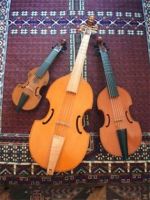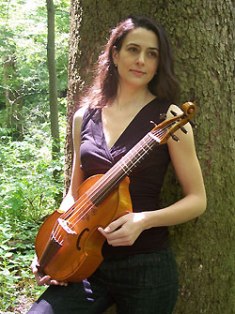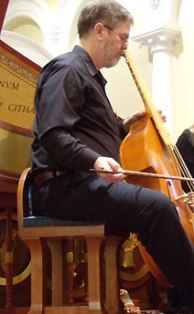Fancying the Viol
Mary Ellyn Hutton
Posted: Nov 15, 2009 - 4:16:07 PM in
reviews_2009

Violas da gamba
|
A "chest of viols" was a household item in England during the 16th and 17th centuries.
(That's "chest" as in "cabinet," "viol" as in "viola da gamba," which is a cousin of the violin played between the legs like a cello.)
People played viols at home as family entertainment. A "consort of viols" was a small ensemble (two or more instruments, six being a typical number) comprising all voices, from treble to bass. A matched set -- think furniture or dishes -- was a prized item kept in its own custom-made chest.
Cincinnati's Catacoustic Consort recalled that long-ago mileu Saturday evening (November 14) at North Presbyterian Church in Northside.

Annalisa Pappano with tenor viola da gamba
|
Joining Catacoustic artistic director/founder Annalisa Pappano were fellow gambists Joanna Blendulf, Micah Fusselman, James Lambert and Mary Burke. Blendulf and Burke flew in from Oregon and Minnesota, respectively (early music specialists are a tightly knit group). Fusselman is a member of Apollo's Cabinet, a Cincinnati baroque ensemble. Lambert, a founding member of Apollo's Cabinet, with which he performed for 15 years, is a member of the double bass section of the Cincinnati Symphony Orchestra.
As heard in the intimate sanctuary of the gothic-styled church, it was like balm for the soul.
The program was dubbed "Fellowship of the Viol" (the word "consort," derives in part from the Latin word for "fellowship"). There were selections by English, Flemish, French, Italian, Spanish and German composers, including Johann Sebastian Bach, whose great Passacaglia in C Minor, BWV 582, was heard in a transcription for five viols.
In addition to being shaped and played differently, the viola da gamba has a gentle voice, unlike the brighter-toned violin (one reason why the violin became predominant). The instrument -- fretted and with six strings as opposed to the violin's four -- is enjoying a revival, due to ensembles like Fretwork, film soundtracks and even new music by contemporary composers. It is fun to watch the players, who hold their bows in the "German grip" used by orchestral double bassists (the double bass is a direct descendant of the viol) and must re-tune their softer gut strings frequently.
The concert began in the British Isles, with Fantasy No. 1 by Orlando Gibbons (1583-1625) and "In Nomine" by Christopher Tye (C.1505-1573), both for treble (Blendulf), tenor (Pappano) and two bass viols (Burke and Lambert). Blendulf displayed a pure, sweet sound, uncannily similar in timbre (tone color) to a wind instrument, and the entire ensemble played with considerable nuance and expression.
The second set comprised works by early-baroque Italian composers Tarquinio Merula (1594/5-1665) and Giovanni Maria Trabaci (c.1575-1647). Merula's "L'Orbina" had a mournful cast. A cheerful Ricercar by Trabaci followed two more severe Trabaci selections.
Bach's Passacaglia for viols works as long as you forget the organ's powerful sonority and let it speak for itself in the viol's more subdued voice. The ensemble -- five viols, with Fusselman on tenor -- gave it a proud reading, well matched to the work's contrapuntal complexities.

James Lambert on bass viola da gamba
|
Composers of Flanders and France began the second half. Following a tune by the most prolific composer in history, i.e. Anonymous, came a movement based on it from the Mass "Wohlauf gesell von hinnen" by Heinrich Isaac (c.1450-1517). With just tenors and basses, Isaac's music bubbled up from Lambert's bass into a denser and darker texture than the original. There was a majestic "Salve Regina" by polyphonic master Johannes Ockeghem (c.1410-1497), again for tenors and basses, and an "Ave Maria," with Blendulf back on treble, by one of the greatest of all Renaissance composers, Josquin des Pres (c.1450/5-1521).
"Paduana Dolorosa," a three-part work by Bach contemporary Samuel Scheidt (1587-1654) was very affecting. Final set was Pappano's favorite, she said, with secular works by Antonio de Cabecon (c.1510-1566) and his son Hernando (1541-1602), both favorites of the Spanish court. The elder Cabecon's "La dame le demanda" had a hymn-like, strophic structure with considerable elaboration by the five players. Hernando's "Susana un jur" -- a favorite Renaissance tune about a shepherdess who says "no" to an amorous approach, said Pappano -- seemed somewhat tinged with regret.
Seen in the crowd were Judith and Allen Martin, retired violists with the Cincinnati Symphony Orchestra. Allen Martin has been a violist of both kinds. Before coming to Cincinnati to join the viola section of the CSO, he was both a violist and a viola da gambist in Cleveland, where he played tenor viol in an eminent Cleveland consort.
Other Catacoustic concerts this season include:
"A Christmas Fanfare." December 19. 7:30 p.m. December 19. North Presbyterian Church, Northside. Seasonal music featuring the cornetto.
"The Sweet Song of the Baroque Oboe." 7:30 p.m. February 6. North Presbyterian Church, Northside. 3 p.m. February 7, St. Gabriel Catholic Church, Glendale. "Show and tell" featuring the baroque oboe.
"Passion and Silence." 7:30 p.m. March 11. Carnegie Visual and Performing Arts Center, Covington. Music of the Italian cloister.
"Ahhh . . . Bach." 7:30 p.m. April 17. Walnut Hills Christian Church, East Walnut Hills. 3 p.m. April 18, St. Gabriel Catholic Church, Glendale. Cantata No. 106, "Gottes Zeit ist die allerbeste Zeit," ("God's time is the best of all times") by J.S. Bach.
Admission is $20 per concert, $7 for students, at the door, or call (513) 772-3242. Children 12 and under free.
For further information, visit www.catacoustic.com



